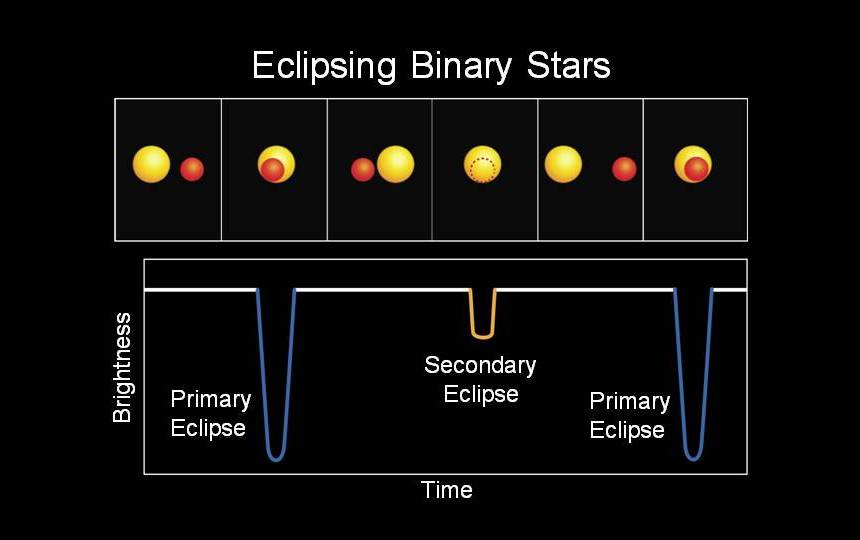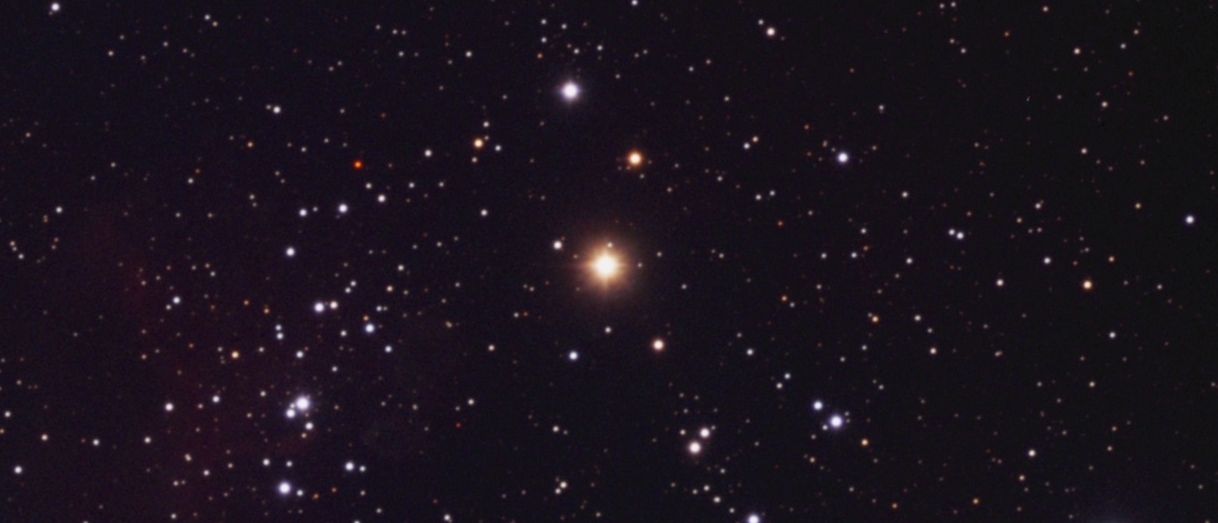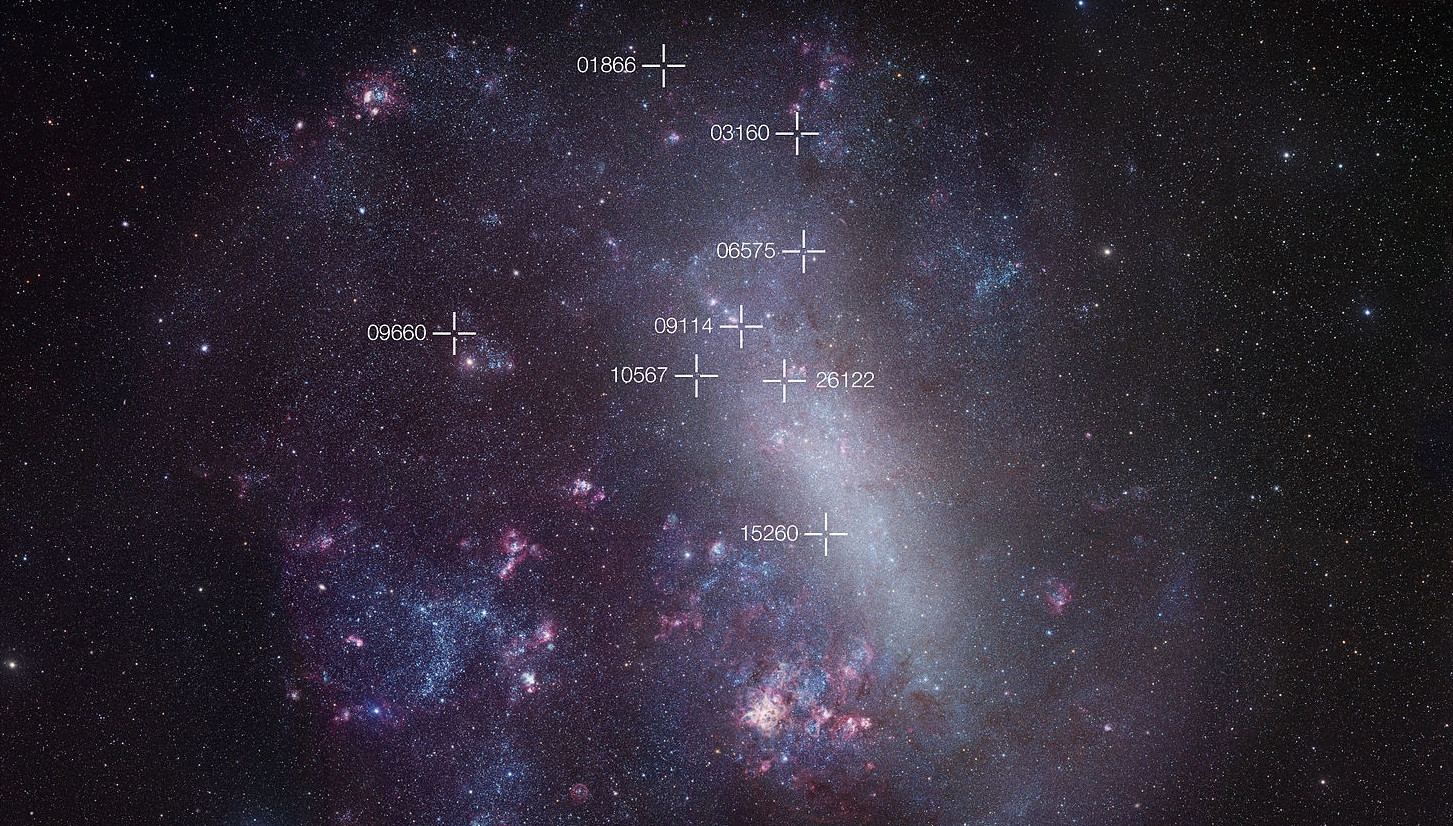Cosmic Staircase 4 - Eclipsing Binary Stars
When the smaller star partially blocks the larger star, a primary eclipse occurs, and a secondary eclips occurs when the smaller star is occulted. Source - Wikimedia, NASA
Beta Aurigae or Menkalinan. Source - Wikipedia, David Ritter
Binary stars are systems in which two stars orbit each other around a common centre of gravity. It is estimated that more than half and maybe as much as two thirds of star systems are binaries. If Jupiter had been significantly bigger it could have been a small star companion to our sun. Many of these are aligned with respect to earth so that they alternately eclipse each other. When such an eclipse occurs the brightness diminishes for a time, which can range from minutes to years. In most cases the stars have different sizes, brightness and density. Other variables are period of orbit and distance between the two stars. If the stars are so close that they exchange mass then the other variables change over time too. The stars are usually very different, so that while one of the eclipses might be total (larger eclipsing smaller), the other can sometimes be barely seen. On the other hand there are plenty to choose from.
SS Leporis was observed using the VLT interferometre at the Paranal Observatory in Chile, %) times sharper than Hubble. Source - Wikimedia, ESO/Pionier/IPAG
Beta Aurigae or Menkalinan is an eclipsing binary that has a very cool and diaphanous supergiant. It is so rarified that when its hot blue star companion is behind it it still shows through the supergiant viewed from Earth. This combination of the light of the supergiant penetrated by the light of its companion, allows spectroscopic analysis to work out the composition and density of the supergiant as well as its temperature.
SS Leporis ( left) is a binary star and this image is one of the sharpest so far made of a binary system allowing much more accurate measurements to be made. This improvement in imaging can only get better.
What is exciting about these detailed observations, especially the variations in brightness, is that it allows us to determine other things about the system:
Whether the orbits are circular or elliptic
The mass, size and luminosity of the stars
Surface temperature of the stars
Chemical compositions by spectral analysis
And most importantly, distance from earth
Even better, it turns out to be one of the most accurate techniques for measuring distance, with margins of error well within ± 5%.
Binary stars have been observed for a very long time. Although the invention of the telescope really got the ball rolling, there is evidence of much earlier observations, even an Egyptian calendar from 3,200 years ago that identified the binary star Algol, which is 90 light years from earth. This same star system is also associated with the Gorgon from Greek mythology, and the Ghoul from Arabic mythology. These suggest that binary stars were well known before 17th century.
The Ara Cluster, Where super and hypergiant binaries established the distance as 12,000 light years. Source - Flckr, Brandon G. Lima
The first person to describe the light variation in Algol, also known as Beta Persei, was Geminciano Montanari, an Italian astronomer in 1670. It was 118 years later in 1782 that the English astronomer John Goodricke measured the cycle of 69 days and first suggested it was an eclipsing binary. From the 17th century onwards eclipsing binaries were identified all over the Milky Way. The nearest to the Earth is CC Eridani, which has one of the shortest orbital periods of 1.56 days and is 38 light years away.
The Large Magellanic Cloud showing the location of eight eclipsing binaries. Source - European Southern Observatory - Credit ESO/R. Gendler
Westerlund 1, or the Ara Cluster is a very young super star cluster in the Milky Way, about 12,000 light years from Earth. It is one of the largest young and rapidly developing clusters in the galaxy. It contains many rare massive stars called yellow hypergiants and red supergiants. Alceste Bonanos and Eugenia Koumpia of the National Observatory of Athens studied 4 massive eclipsing binaries in 2012, establishing the distance above.
Source - Nik. C.
It is only in recent times that developments in telescope design have made it possible to calculate the distances to binary stars in other galaxies. Starting in the early 1990s a number of projects were developed to study stars in nearby galaxies. One example, the EROS Experiment, identified 75 binaries in the Large Magellanic Cloud (LMC). To date we have measured the distance to eclipsing binaries in the LMC, the Small Magellanic Cloud (SMC), Andromeda and Triangulum galaxies. Like the LMC near the Milky Way, Triangulum is an Andromeda groupie.
This method has the obvious limitation that eclipsing binaries are difficult to find in more distant galaxies. The furthest it is currently possible to use this technique is around 10 million light years, although this is bound to improve as telescopes get better.
Finally, the CHARA array, near the Mount Wilson Observatory, is an optical astronomical interferometer. This is an array of six telescopes that observe at near infrared wavelengths. In 2009 CHARA studied the Algol binary mentioned above. The link below will take you to an animation of 55 images showing the motions of the binary pair taken by this telescope.




